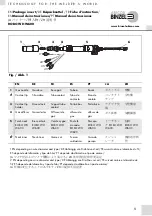
JA-14K(R) Security System Control Panel
44 / 72
MNX22101
Internal
– this parameter is only available for intrusion detectors. Signals from devices with this indication are
not evaluated as alarm signals if a section is partially set. Partial setting of a section - see chapter 10.2 Sections
Internal settings
– access to settings of internal parameters of perimeters that are connected to the BUS
or feature bidirectional wireless communication. Individual devices have different internal parameters (some
have none). Settings are described in their manuals.
Disable
– can be performed at 2 levels given by your authorization:
1. Input blocking
(yellow dot), serves for the permanent blocking of the detector’s input (BLK). The system
ignores any device activation = an alarm is not triggered and the PG is not controlled but tamper alarms
and faults are registered as usual.
2. Device disabling
(red dot), serves for the device to be completely disabled (Disabled). The system ignores
all connected device functions = no alarm, tampering, PG activation, Fault, report,...).
You cannot disable the control panel or a device whose reaction is set to Panic.
Status
– indicates the current status of the device. OK = everything all right, TMP = tampering, ACT = alarm
input activated, BLK = blocked, Disabled = Disabled, ERR = error, ?? = no communication with the device,
Mains supply = supply failure, Battery = discharged or disconnected battery in the control panel, Charging –
charging the backup battery in the device or control panel, BOOT – upgrading of the device is going on or
upgrade failure (repeat upgrade). By moving the mouse cursor on the device STATUS you will display detailed
data.
Note
– it allows you to describe details of the device, e.g. location, last battery replacement date, mean RF
signal strength during the last testing etc.
10.4 Users tab
It is used to establish new system users and to set their rights. Up to 17 positions for users can be defined.
To make changes in this tab you do not need to be in Service mode.
Name
– names of users are used in textual event reports in the readouts of the event history, in tabs for reports,
authorization settings or for authorization on a keypad or in SMS reports sent by supplementary GSM
communicator.
Telephone number
– used for reporting events when supplementary communicators are connected and for
identification of users when the system is controlled by phone using a voice menu or for activation of PG outputs
by ringing and SMS. The phone number must always be entered in the international format (e.g.
+420777123456).
Code
– the user access code is entered in the format
nnnn
(4 or 6 digits according to the system profile).
The code on positions 0 ,1 and 2 cannot be deleted (Service, Main Administrator and ARC).
Card
– used to assign RFID access tags. Each user can be assigned by tags.
Tags can be assigned:
−
by entering the serial number (it can be read with a barcode reader from the RFID tag)
−
using any keypad and applying an RFID tag
Authorization
– defines user rights. The authorizations on position 0, 1 and 2 cannot be changed.
Details - see chapter 8.3 Authorisation of users.
















































